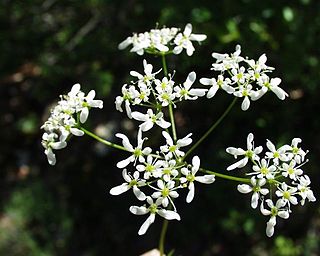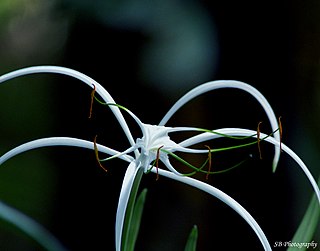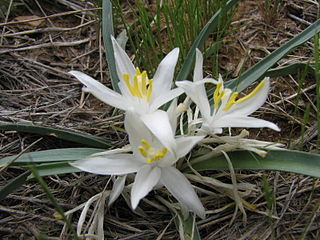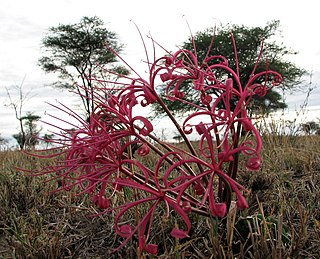
In botany, a bulb is structurally a short stem with fleshy leaves or leaf bases that function as food storage organs during dormancy.

Acorus calamus is a species of flowering plant with psychoactive chemicals. It is a tall wetland monocot of the family Acoraceae, in the genus Acorus. Although used in traditional medicine over centuries to treat digestive disorders and pain, there is no clinical evidence for its safety or efficacy – and ingested calamus may be toxic – leading to its commercial ban in the United States.

Crinum is a genus of about 180 species of perennial plants that have large showy flowers on leafless stems, and develop from bulbs. They are found in seasonally moist areas, including marshes, swamps, depressions and along the sides of streams and lakes in tropical and subtropical areas worldwide.

Solanum americanum, commonly known as American black nightshade, small-flowered nightshade or glossy nightshade, is a herbaceous flowering plant of wide though uncertain native range. The certain native range encompasses the tropics and subtropics of the Americas, Melanesia, New Guinea, and Australia.

Crinum pedunculatum also known as the swamp lily, river lily or mangrove lily, is a bulbous perennial found in stream and tidal areas of the Northern Territory, Queensland and New South Wales, Australia as well as New Guinea and some Pacific Islands. It is unclear whether it is native or introduced to Norfolk Island.
The greater Brisbane area of Queensland Australia, has many species of indigenous flora. This article links the flora to its geography with:

Erythronium americanum, the trout lily, yellow trout lily, or yellow dogtooth violet, is a species of perennial, colony forming, spring ephemeral flower native to North America and dwelling in woodland habitats. Within its range it is a very common and widespread species, especially in eastern North America. The common name "trout lily" refers to the appearance of its gray-green leaves mottled with brown or gray, which allegedly resemble the coloring of brook trout.

Bifora is a cosmopolitan genus of flowering plant in the family Apiaceae, of disjunct distribution, with 3 species, two Eurasian and one American.

Lilium superbum is a species of true lily native to the eastern and central regions of North America. Common names include Turk's cap lily, turban lily, swamp lily, lily royal, or American tiger lily. The native range of the species extends from southern New Hampshire, Massachusetts, and New York, west to Illinois, Missouri, and Arkansas, and south to Georgia, Alabama, Mississippi, and Florida.

Spider lily is the common name for a number of different plant species within the family Amaryllidaceae which belong to the following genera:

Leucocrinum montanum, commonly known as the sand lily, common starlily or mountain lily, is the only species in the monotypic genus Leucocrinum, placed in the family Asparagaceae, and subfamily Agavoideae. It is native to the western United States, primarily in the Rocky Mountains and the Great Basin.

Zephyranthes robusta, synonym Habranthus robustus, commonly known as the Brazilian copperlily, pink fairy lily or the pink rain lily, is a species of herbaceous flowering bulb. It is native to Brazil, Argentina and Uruguay, but is now naturalized in Florida, Colombia, South Africa, and Mauritius.

Ammocharis is a small genus from sub-Saharan Africa, in the family Amaryllidaceae which includes seven species distributed in Africa. The plant grows as above-ground bulb, preferring seasonally wet, hot, sandy soils and full sun.

The scientific name × Amarcrinum is applied to those hybrid plants obtained from artificial crosses between the genera Amaryllis and Crinum, although as of March 2014, the World Checklist of Selected Plant Families regards the name as "unplaced". They are grown as ornamental plants in gardens.

Nerine bowdenii is a species of flowering plant in the family Amaryllidaceae. It is an herbaceous bulbous perennial, growing to 45 cm (18 in) tall by 8 cm (3 in), with strap-shaped leaves and large umbels of lily-like pink flowers in late summer and autumn. The common names of the species are Cornish lily, Cape flower, Guernsey lily, and Bowden lily. However, it is neither a true lily nor from Cornwall or Guernsey, but originates from South Africa. Confusingly the name “Guernsey lily” is also applied to a related species, Nerine sarniensis.

Zephyranthes rosea, commonly known as the Cuban zephyrlily, rosy rain lily, rose fairy lily, rose zephyr lily or the pink rain lily, is a species of rain lily native to Peru and Colombia. They are widely cultivated as ornamentals and have become naturalized in tropical regions worldwide. Like all rain lilies, they are known for blooming only after heavy rains.

Crinum moorei is a herbaceous plant belonging to the family Amaryllidaceae, and native to South Africa.

Crinum mauritianum is a herbaceous plant belonging to the family Amaryllidaceae, and endemic to Mauritius.

Crininae is one of four subtribes within the tribe Amaryllideae, with a pantropical distribution (Crinum) and also sub-Saharan Africa.


















